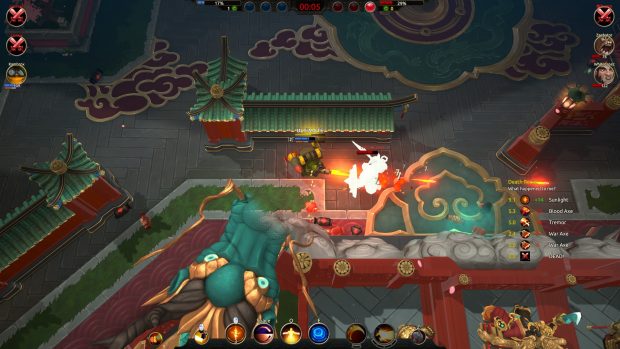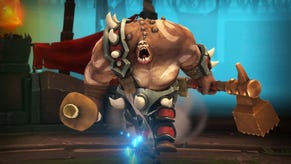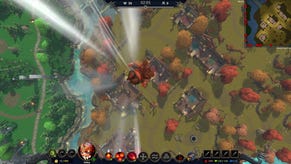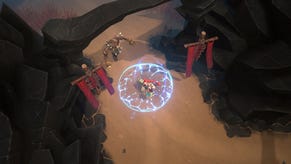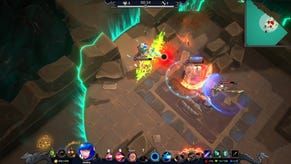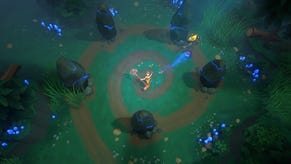Wot I Think: Battlerite
Battle right
Battlerite bills itself as a Team Arena Brawler. It takes the team fights from MOBAs, strips out everything else and distills those fights into intricate ballets of timing, fast reactions and tactics. I’m having a blast.
If you’ve played Bloodline Champions, then things will feel very familiar. Battlerite is Stunlock Studios’ follow up to that game, and is similar to the point where some of the champions have almost the same skillsets as their predecessors.
The premise is fairly simple: players battle each other using abilities from a skill bar in either 2v2 or 3v3 fights that work in a best of five round structure. Things get more complicated when you’re in the thick of things, trying to remember what each of your opponent's 6 unique abilities do when they could be playing any of 21 different champions. That’s nowhere near as much learning as League of Legends or Dota demand, but there are still an intimidating number of spell effects to memorise.
Further complicating things are each champion’s two EX moves, which are alternate abilities that use up energy - generated either by doing damage or collecting little orbs - for effects that are usually more powerful than normal attacks. You don’t want to use them all the time though, because then you’ll never get to use your ‘ultimate’ ability, which can typically tear through your enemies health bars at the cost of entirely depleting your energy pool.
There’s more! At the start of each game, you select a loadout which adds 5 enhancements to your abilities. Those are normally more interesting than simply boosting their damage or duration: they can apply extra effects like stunning them if the ability knocks them into a wall, resetting the cooldown of another skill or healing you for a percentage of the damage you deal. They don’t tend to radically change your playstyle, but they do allow you to tailor your skillset to better counter the skills of your opponents or complement those of your allies.
The loadout system has replaced the one the game had when I last played it, where you’d pick one of three enhancements at the start of each round. I do miss the sense of escalation that gave each match, though having your pick of 5 enhancements from the start does allow you to come up with more interesting and varied builds. You can give the same ability multiple enhancements if you like, which provides you with more choices in an already flexible system.
I got on well with Ashka, a fire imp that can put out a tonne of damage but also has two abilities (three including his ult) that allow him to dodge and reposition. He also has a neat flame wall that sets enemies alight and blocks projectiles, which - with the right perk selected - also turns my default attacks into fireballs. I combined that with a perk that boosted the damage of those type of attacks, and felt like I’d come up with an intelligent, deliciously synergistic build.
As my champion is keen on declaring: ‘Ashka happy foes on fire’.
Every match has something you can learn from. In one game I kept getting focussed down by two melee heroes, and realised too late that I could have used one of my EX abilities to apply a ‘petrify’ effect to them and retreat. That’s also an example of how each match can feel different depending on which heroes are involved, and how you need to switch up your tactics to counter the various abilities of your opponents.
Learning what those abilities are and how to deal with them can feel remarkably rewarding: you can get a feel for what your opponent is thinking, what skills they like to chain together and when they’re most vulnerable. It will take you a while to learn all the nuances, but a simple and satisfying trick that you can start pulling off relatively quickly is to bait out their mobility skill (most champions have at least one ability that’s good for dodging) and then use an ability that would otherwise be hard to land.
Coming up with different builds is interesting, but where Battlerite really shines is - appropriately enough - in the heat of battle. It reminds me a lot of fencing, where a combination of lightning fast reflexes and psychology are key to gaining the upperhand. The same is often true of the team fights in the MOBAs that have inspired Battlerite, except here the whole game is designed around making those clashes as exciting as possible.
All of the abilities are skill shots which require aiming, which puts pressure on every mouse click to be accurate. That applies to healing abilities too, which stops support-focused characters from feeling passive. There’s nothing like the slow build-up phase that revolves around farming creeps in most MOBAs: matches are short, 10 -15 minute affairs where every second is spent locked in that intense, head-to-head brawl.
The game’s at its best when both teams are down to one player, as they dance around each other while the arena contracts and the fate of the game could be decided by a single move. I don’t know whether I prefer to be the person remaining at that point, or the one cheering my teammate on from the grave - it can be almost as fun to watch a skillful play as it is to execute one. Those duels occur more often in 2v2 mode, which is part of the reason I normally pick that one over the more chaotic 3v3 brawls.
There’s a more expansive tutorial than when I last played, though it still doesn’t go into as much detail as I think it could. As I said last year, including a tutorial that encouraged players to look at how their abilities synergise together might introduce more people to the deeper side of the game. It also doesn’t do a good enough job of explaining how the orb works that periodically spawns at the centre of each map. The team that destroys the orb is rewarded with health, energy or a combination of the two - there are three different varieties and I’m still not sure exactly which does what.
With 21 champions now in the game, there’s a lot to learn - so everything that Stunlock Studios can do to smooth out that learning curve is vital. There’s a practice mode which is a good step in the right direction, though it’s still the area of the game that I think could most do with improvement. The only other thing holding it back is that in an ideal world, the free-to-play business model would have only sold cosmetics rather than champions. You can buy every champion with currency that you earn in game, but getting them all will take a long time. It's frustrating because the the best way to understand how to beat a champion is to play a few games as that character, and for that reason I'd recommend biting the bullet and picking up the £23.79 pack that unlocks them all.
I can point to one thing that will make me keep coming back to Battlerite, and that's the way that after every death I say to myself: 'I could have avoided that'. If I'd read my opponent better, if I'd timed that ability correctly, if my aim had been more accurate - then victory could have been mine. I'll never anguish over it for long though, because a few minutes later I can be in the thick of another match. Battlerite takes the best part out of MOBAs, making the joy of teamfights accessible to anyone who's only interested in that element of the genre.
Battlerite is out now on Windows via Steam and is free-to-play with money charged to unlock characters.





